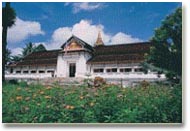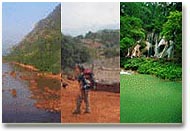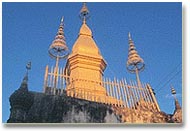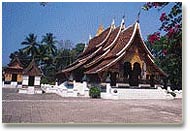|  Archaeological evidence suggests that Luang Prabang has been inhabited since at least 8,000 BC. The first Laos kingdom, Lane Xang, was founded here in the 14th century by King Fa Ngum after he conquered and unified the lands of modern-day Xiengkhouang , the Khorat Plateau and Luang Prabang. The city was first reffered to as Muang Swa and by 1357 the name was again changed to Muang Xieng Dong Xieng Thong by local inhabitants. Shortly thereafter, King Fa Ngum accepted a golden Buddha image called the Pha Bang as a gift from the Khmer monarchy and the thriving city-state became known as Luang Prabang.Luang Prabang was the capital of Lane Xang until moved to Vientiane in 1545 by King Setthathirath (although Luang Prabang remained the country's main religious centre). The city's first contact with western emissaries occurred in the mid 17th century during the reign of King Surigna Vongsa. After his death in 1694, Lane Xang broke up into three separate Kingdoms; Vientiane, Champasack and Luang Prabang. Archaeological evidence suggests that Luang Prabang has been inhabited since at least 8,000 BC. The first Laos kingdom, Lane Xang, was founded here in the 14th century by King Fa Ngum after he conquered and unified the lands of modern-day Xiengkhouang , the Khorat Plateau and Luang Prabang. The city was first reffered to as Muang Swa and by 1357 the name was again changed to Muang Xieng Dong Xieng Thong by local inhabitants. Shortly thereafter, King Fa Ngum accepted a golden Buddha image called the Pha Bang as a gift from the Khmer monarchy and the thriving city-state became known as Luang Prabang.Luang Prabang was the capital of Lane Xang until moved to Vientiane in 1545 by King Setthathirath (although Luang Prabang remained the country's main religious centre). The city's first contact with western emissaries occurred in the mid 17th century during the reign of King Surigna Vongsa. After his death in 1694, Lane Xang broke up into three separate Kingdoms; Vientiane, Champasack and Luang Prabang.
 By the late 19th century Luang Prabang was under attack by marauding Black Flag bandits who destroyed many sacred Buddha images, temples and historical documents. Under King Sisavang Vong (1904-1959) a number of restoration and beautification projects were launched, many of which are still evident today. French influenced buildings began to appear in the later 1800's, adding to the mixture of Lao, Tai-Lue, Burmese, Chinese and Tai architecture. By the late 19th century Luang Prabang was under attack by marauding Black Flag bandits who destroyed many sacred Buddha images, temples and historical documents. Under King Sisavang Vong (1904-1959) a number of restoration and beautification projects were launched, many of which are still evident today. French influenced buildings began to appear in the later 1800's, adding to the mixture of Lao, Tai-Lue, Burmese, Chinese and Tai architecture.
Luang Prabang is rich in cultural heritage, and is known as the seat of Lao culture, with monasteries, monuments traditional costumes and surrounded by many types of nature's beauty. Luang Prabang province has a total population of 365,000. It is one of two World Heritage Sites in Laos named by UNESCO. |


 Archaeological evidence suggests that Luang Prabang has been inhabited since at least 8,000 BC. The first Laos kingdom, Lane Xang, was founded here in the 14th century by King Fa Ngum after he conquered and unified the lands of modern-day Xiengkhouang , the Khorat Plateau and Luang Prabang. The city was first reffered to as Muang Swa and by 1357 the name was again changed to Muang Xieng Dong Xieng Thong by local inhabitants. Shortly thereafter, King Fa Ngum accepted a golden Buddha image called the Pha Bang as a gift from the Khmer monarchy and the thriving city-state became known as Luang Prabang.Luang Prabang was the capital of Lane Xang until moved to Vientiane in 1545 by King Setthathirath (although Luang Prabang remained the country's main religious centre). The city's first contact with western emissaries occurred in the mid 17th century during the reign of King Surigna Vongsa. After his death in 1694, Lane Xang broke up into three separate Kingdoms; Vientiane, Champasack and Luang Prabang.
Archaeological evidence suggests that Luang Prabang has been inhabited since at least 8,000 BC. The first Laos kingdom, Lane Xang, was founded here in the 14th century by King Fa Ngum after he conquered and unified the lands of modern-day Xiengkhouang , the Khorat Plateau and Luang Prabang. The city was first reffered to as Muang Swa and by 1357 the name was again changed to Muang Xieng Dong Xieng Thong by local inhabitants. Shortly thereafter, King Fa Ngum accepted a golden Buddha image called the Pha Bang as a gift from the Khmer monarchy and the thriving city-state became known as Luang Prabang.Luang Prabang was the capital of Lane Xang until moved to Vientiane in 1545 by King Setthathirath (although Luang Prabang remained the country's main religious centre). The city's first contact with western emissaries occurred in the mid 17th century during the reign of King Surigna Vongsa. After his death in 1694, Lane Xang broke up into three separate Kingdoms; Vientiane, Champasack and Luang Prabang. By the late 19th century Luang Prabang was under attack by marauding Black Flag bandits who destroyed many sacred Buddha images, temples and historical documents. Under King Sisavang Vong (1904-1959) a number of restoration and beautification projects were launched, many of which are still evident today. French influenced buildings began to appear in the later 1800's, adding to the mixture of Lao, Tai-Lue, Burmese, Chinese and Tai architecture.
By the late 19th century Luang Prabang was under attack by marauding Black Flag bandits who destroyed many sacred Buddha images, temples and historical documents. Under King Sisavang Vong (1904-1959) a number of restoration and beautification projects were launched, many of which are still evident today. French influenced buildings began to appear in the later 1800's, adding to the mixture of Lao, Tai-Lue, Burmese, Chinese and Tai architecture. 


